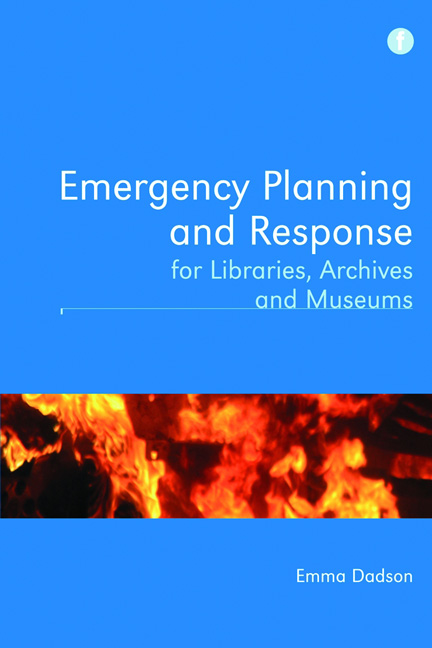Book contents
- Frontmatter
- Contents
- Foreword
- Preface
- Acknowledgements
- 1 Introduction
- 2 Case studies
- 3 Roles and responsibilities
- 4 Incident control
- 5 Planning the recovery operation
- 6 Collections salvage
- 7 Supplementary content
- 8 Dealing with the building
- 9 Business continuity
- 10 Ensuring the plan's efficacy
- 11 Conclusion
- Bibliography and references
- Index
10 - Ensuring the plan's efficacy
Published online by Cambridge University Press: 08 June 2018
- Frontmatter
- Contents
- Foreword
- Preface
- Acknowledgements
- 1 Introduction
- 2 Case studies
- 3 Roles and responsibilities
- 4 Incident control
- 5 Planning the recovery operation
- 6 Collections salvage
- 7 Supplementary content
- 8 Dealing with the building
- 9 Business continuity
- 10 Ensuring the plan's efficacy
- 11 Conclusion
- Bibliography and references
- Index
Summary
It is vital to write a plan determining your emergency procedures, but this is only the initial step in ensuring you can make an effective emergency response. However good an emergency plan is in theory, additional effort is required to make sure that the content is well presented and userfriendly, and that staff can confidently and competently implement it.
Making your plan user-friendly
Consider the potential circumstances of implementing an emergency plan. It could be dark, your workplace under the control of the fire services, with an unknown amount of damage to collections you've striven for years to preserve. Good procedures and content are critical, but so is the presentation of that information. Where possible, use bullet points, tables and flowcharts to communicate procedures rather than prose. The rationale behind the instructions should already be understood by the Emergency Management Team through preincident training and familiarization. It should not be necessary to justify your recommended procedure with explanatory padding. Such information merely adds to the girth of the plan, which can make it unwieldy.
It is very helpful to salvage volunteers if salvage information is presented in a table, with all relevant formats listed in the first column, followed by basic guidance on packing, airdrying and dealing with large incidents (as in Table 10.1 overleaf); this can act as an invaluable checklist. Instructions for individual formats on a single sheet can also be provided and included in kits in a larger font size, together with photographs of the techniques required. Laminate these if possible.
Try to use a large font size. Avoid jargon wherever possible and use simple and direct language. Some institutions prefer to use paragraph numbering systems rather than bullets so that particular paragraphs can be referred to with maximum speed. Use page numbers and provide a contents page.
Diagrams and photographs are very useful to demonstrate techniques that are complex to explain in text. A photograph of a wind tunnel may be easier to follow than written instructions on how to construct one. Disaster kits should have contents of containers listed, and individual paper types labeled so salvage staff can be reminded what they are for, as outlined in Chapter 7.
- Type
- Chapter
- Information
- Publisher: FacetPrint publication year: 2012



